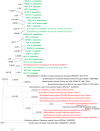South african papilionoid legumes are nodulated by diverse burkholderia with unique nodulation and nitrogen-fixation Loci
- PMID: 23874611
- PMCID: PMC3708930
- DOI: 10.1371/journal.pone.0068406
South african papilionoid legumes are nodulated by diverse burkholderia with unique nodulation and nitrogen-fixation Loci
Abstract
The root-nodule bacteria of legumes endemic to the Cape Floristic Region are largely understudied, even though recent reports suggest the occurrence of nodulating Burkholderia species unique to the region. In this study, we considered the diversity and evolution of nodulating Burkholderia associated with the endemic papilionoid tribes Hypocalypteae and Podalyrieae. We identified distinct groups from verified rhizobial isolates by phylogenetic analyses of the 16S rRNA and recA housekeeping gene regions. In order to gain insight into the evolution of the nodulation and diazotrophy of these rhizobia we analysed the genes encoding NifH and NodA. The majority of these 69 isolates appeared to be unique, potentially representing novel species. Evidence of horizontal gene transfer determining the symbiotic ability of these Cape Floristic Region isolates indicate evolutionary origins distinct from those of nodulating Burkholderia from elsewhere in the world. Overall, our findings suggest that Burkholderia species associated with fynbos legumes are highly diverse and their symbiotic abilities have unique ancestries. It is therefore possible that the evolution of these bacteria is closely linked to the diversification and establishment of legumes characteristic of the Cape Floristic Region.
Conflict of interest statement
Figures



Similar articles
-
Emergence of β-rhizobia as new root nodulating bacteria in legumes and current status of the legume-rhizobium host specificity dogma.World J Microbiol Biotechnol. 2020 Feb 24;36(3):40. doi: 10.1007/s11274-020-2811-x. World J Microbiol Biotechnol. 2020. PMID: 32095903 Review.
-
Characterization of the papilionoid-Burkholderia interaction in the Fynbos biome: The diversity and distribution of beta-rhizobia nodulating Podalyria calyptrata (Fabaceae, Podalyrieae).Syst Appl Microbiol. 2016 Feb;39(1):41-8. doi: 10.1016/j.syapm.2015.09.006. Epub 2015 Nov 22. Syst Appl Microbiol. 2016. PMID: 26689612
-
Symbiotic diversity, specificity and distribution of rhizobia in native legumes of the Core Cape Subregion (South Africa).FEMS Microbiol Ecol. 2015 Feb;91(2):1-17. doi: 10.1093/femsec/fiu024. Epub 2014 Dec 8. FEMS Microbiol Ecol. 2015. PMID: 25764552
-
Biogeographical Patterns of Legume-Nodulating Burkholderia spp.: from African Fynbos to Continental Scales.Appl Environ Microbiol. 2016 Aug 15;82(17):5099-115. doi: 10.1128/AEM.00591-16. Print 2016 Sep 1. Appl Environ Microbiol. 2016. PMID: 27316955 Free PMC article.
-
Legume-nodulating betaproteobacteria: diversity, host range, and future prospects.Mol Plant Microbe Interact. 2011 Nov;24(11):1276-88. doi: 10.1094/MPMI-06-11-0172. Mol Plant Microbe Interact. 2011. PMID: 21830951 Review.
Cited by
-
Paraburkholderia atlantica sp. nov. and Paraburkholderia franconis sp. nov., two new nitrogen-fixing nodulating species isolated from Atlantic forest soils in Brazil.Arch Microbiol. 2020 Aug;202(6):1369-1380. doi: 10.1007/s00203-020-01843-w. Epub 2020 Mar 12. Arch Microbiol. 2020. PMID: 32166359
-
High-quality permanent draft genome sequence of the Mimosa asperata - nodulating Cupriavidus sp. strain AMP6.Stand Genomic Sci. 2015 Oct 16;10:80. doi: 10.1186/s40793-015-0074-1. eCollection 2015. Stand Genomic Sci. 2015. PMID: 26478786 Free PMC article.
-
Specificity in Legume-Rhizobia Symbioses.Int J Mol Sci. 2017 Mar 26;18(4):705. doi: 10.3390/ijms18040705. Int J Mol Sci. 2017. PMID: 28346361 Free PMC article. Review.
-
Differential Preference of Burkholderia and Mesorhizobium to pH and Soil Types in the Core Cape Subregion, South Africa.Genes (Basel). 2017 Dec 22;9(1):2. doi: 10.3390/genes9010002. Genes (Basel). 2017. PMID: 29271943 Free PMC article.
-
Emergence of β-rhizobia as new root nodulating bacteria in legumes and current status of the legume-rhizobium host specificity dogma.World J Microbiol Biotechnol. 2020 Feb 24;36(3):40. doi: 10.1007/s11274-020-2811-x. World J Microbiol Biotechnol. 2020. PMID: 32095903 Review.
References
-
- Lock JM (1989) Legumes of Africa: a check-list. UK: Royal Botanic Gardens, Kew.
-
- Goldblatt P, Manning JC (2002) Plant diversity of the Cape region of southern Africa. Ann Mo Bot Gard 89: 281–302.
-
- Raven PH, Polhill RM (1981) Biogeography of the Leguminosae. In: Polhill RM, Raven PH, editors. Advances in legume systematics Part1. UK: Royal Botanic Gardens, Kew. 27–34.
-
- Jaftha JB (2002) Polyphasic taxonomy of rhizobia associated with legumes occurring in South Africa. PhD thesis, Pretoria: University of Pretoria.
-
- Ardley JK, O’Hara GW, Reeve WG, Yates RJ, Dilworth MJ, et al. (2009) Root nodule bacteria isolated from South African Lotononis bainesii, L. listii and L. solitudinis are species of Methylobacterium that are unable to utilize methanol. Arch Microbiol 191: 311–318. - PubMed
Publication types
MeSH terms
Substances
LinkOut - more resources
Full Text Sources
Other Literature Sources
Molecular Biology Databases

